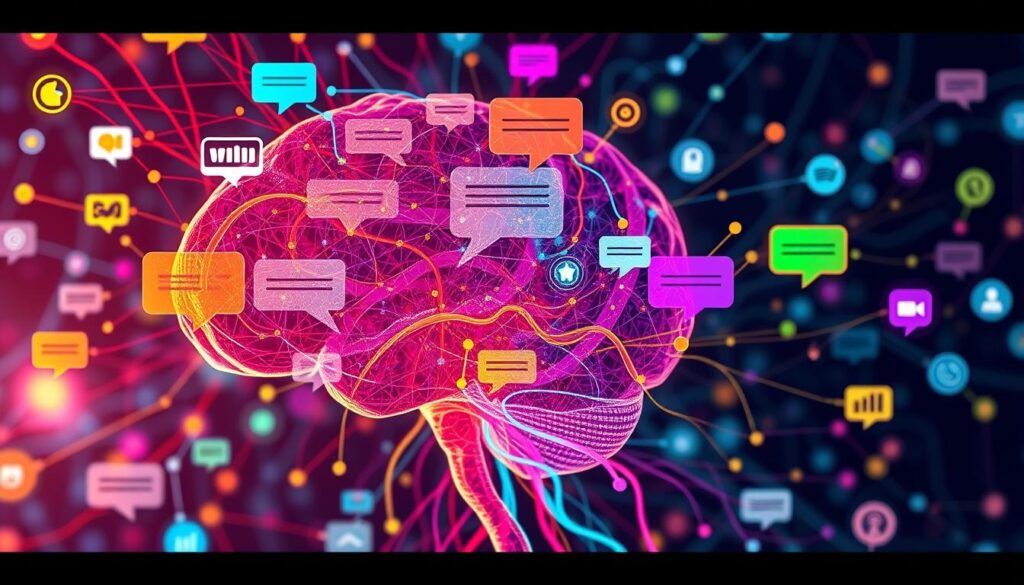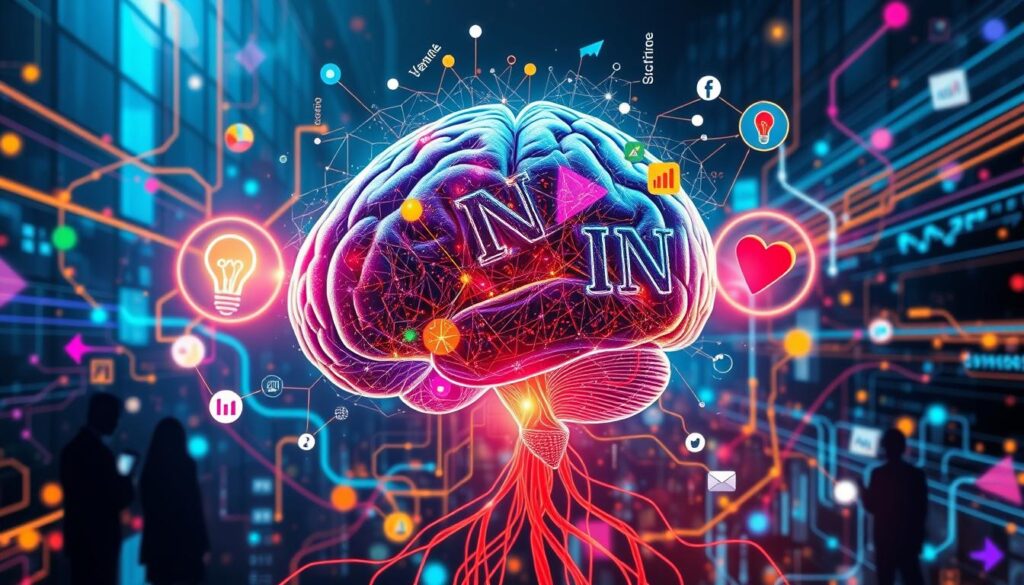
Ever wondered why some ads stick with you, while others disappear? It’s not just luck. We’re exploring a world where science meets marketing, where our brains and actions are the main attraction.
Imagine walking through a store, surrounded by colors, sounds, and smells. You’re drawn to certain products without even realizing it. That’s neuromarketing at work, a secret chat between brands and our subconscious.
Picture a salesperson who knows exactly what to say to win you over. They’re using NLP, tapping into the power of words to connect with you deeply. These aren’t just buzzwords – they’re real tools changing how we talk in marketing.
We’re about to dive into how NLP and neuromarketing can change how brands talk to us. We’ll look at persuasive language and how to influence us without us even realizing it.
Get ready to see marketing in a new light. It’s not just about selling things. It’s about understanding our minds and making real connections.
Key Takeaways
- NLP and neuromarketing combine science and marketing strategy
- Subconscious decision-making plays a crucial role in consumer behavior
- Persuasive language patterns can significantly impact marketing effectiveness
- Understanding sensory preferences enhances communication strategies
- Emotional intelligence in marketing creates stronger brand connections
- Ethical considerations are vital in neuromarketing practices
- NLP techniques can improve sales and customer relationships
The Intersection of Neuroscience and Marketing
Neuroscience and marketing have merged, changing how we see consumer behavior. This new field, neuromarketing, studies how our brains react to marketing. Tools like fMRI and EEG help marketers see what’s happening in our minds.

Understanding the Brain’s Response to Marketing Stimuli
Our brains handle marketing messages in unique ways. Research shows 95% of buying decisions are made without us realizing it. This fact has led marketers to use neurolinguistic programming to reach our subconscious.
By knowing how our brains react, we can make marketing that grabs our attention better.
The Role of Subconscious Decision-Making in Consumer Behavior
The subconscious mind is key in making our choices. Studies reveal 78% of what we see is processed in just 9 seconds. This shows how fast and visual marketing must be.
By focusing on the limbic system, which handles emotions and memory, we can connect with people on a deeper level.
Bridging the Gap Between Science and Marketing Strategy
To use neuroscience in marketing, we need to link science with strategy. This means using emotional intelligence and neurolinguistic programming. By doing this, we can make marketing that truly speaks to us.
| Region | Advertising Expenses (2023) |
|---|---|
| USA and Canada | $311.1 billion |
| Asia Pacific Countries | $241.5 billion |
| Western Europe | $135.2 billion |
| Latin America | $23.8 billion |
| Middle East and Africa | $8.9 billion |
| Central Europe | $7.5 billion |
As we dive deeper into the mix of neuroscience and marketing, we open up new ways to connect with people. By understanding our brains, we can make marketing that feels more natural and instinctive.
Decoding Neuro-Linguistic Programming (NLP)
Neuro-Linguistic Programming (NLP) helps us understand and shape human behavior. It lets us see how people see the world and talk. This knowledge helps us make marketing messages that really connect with our audience.

Priming and anchoring are key in NLP. Priming is about gently planting ideas that shape our thoughts and actions later. For instance, using black in ads for luxury boats can make people think of luxury and exclusivity.
Anchoring is about making sure our message sticks. It focuses on the start and end of our message. This way, our marketing stays in people’s minds longer and has a bigger impact.
Mirroring and building rapport are also important in NLP. By matching our audience’s style and tone, we build trust. This is especially useful in digital marketing, where we can customize our content for different groups.
| NLP Technique | Application in Marketing | Potential Impact |
|---|---|---|
| Priming | Color psychology in ads | Increased engagement |
| Anchoring | Strategic information placement | Enhanced memorability |
| Mirroring | Tailored communication styles | Improved rapport and trust |
Using NLP in our marketing makes our messages more persuasive. It helps us connect better with our customers. This leads to more effective marketing that really engages and converts people.
The Evolution of Neuromarketing
Neuromarketing has changed how we understand consumer behavior. It started in the 1990s, combining neuroscience and marketing. This mix helps us see what drives people to buy things.
In 2002, a Dutch marketing professor named it “Neuromarketing.” This was a big step forward for the field.
From Traditional Marketing to Brain-Based Approaches
The move from old marketing to neuromarketing is amazing. Now, we use tools like EEG and fMRI to see how people react. This helps make ads that really work, based on what we know about people’s minds.

Key Pioneers in the Field of Neuromarketing
Leaders in neuromarketing have made it grow and be trusted. Ariely and Berns’ 2010 paper is a big hit, with 426 citations. Spain is leading in neuromarketing research, thanks to new tools like fMRI.
Today, more than 150 companies worldwide focus on consumer neuroscience. This shows how big the field has gotten.
Ethical Considerations in Neuromarketing Practices
As neuromarketing grows, thinking about ethics is more important. A study by Pop et al. (2017) looked at ethical issues in neuromarketing. It’s key to respect people’s choices while using these powerful tools.
Emotional intelligence in marketing helps solve these ethical problems. It makes sure neuromarketing stays fair and good for consumers.
AI and machine learning are changing how we connect with customers. Big names like Google and Unilever use these tools to shape buying choices. This shows how neuromarketing works in today’s digital world.
Leveraging NLP and Neuromarketing for Effective Communication
In today’s world, using NLP and neuromarketing is key for businesses. They can boost their sales and connect with people better. This is done by using persuasive language and understanding emotions in marketing.

Emotions are big in making choices. Marketers use this to guide people’s decisions without them knowing. Visuals, for example, affect people’s choices more than words. This shows how important it is to use eye-catching visuals in ads.
Neurolinguistic Programming (NLP) helps change how people act by reaching their deep desires. By using special words and ways, we can make people feel like they need to act fast. This can really help sell more.
| Neuromarketing Technique | Impact on Consumer Behavior |
|---|---|
| Visual Stimuli | Faster information processing |
| Emotional Triggers | Precede rational thinking |
| Social Proof | Significant impact on decision-making |
| Scarcity Effect | Creates urgency and drives sales |
Using these neuromarketing methods in our plans can make our ads more effective. It’s all about knowing how our brains work. Then, we can tell stories that really speak to our audience.
The Power of Sensory-Based Language in Marketing
Sensory-based language is key in making messages stick. It uses what we see, hear, and feel to grab our attention. This way, marketers can make their messages more engaging and powerful.
Visual, Auditory, and Kinesthetic Communication Styles
People like to get information in different ways. Visual learners like pictures and metaphors. Those who prefer sound enjoy hearing and words. Kinesthetic folks feel things more, like emotions and touch.
Tailoring Messages to Different Sensory Preferences
We can reach more people by using different senses in our marketing. For those who like to see, we use bright images and colors. For sound lovers, catchy tunes or slogans work well.
For those who feel things, we focus on textures and emotions tied to a product.
Creating Multi-Sensory Marketing Experiences
The best marketing hits us in many ways at once. A study showed that smells can really sway us. Brands like McDonald’s and Coca-Cola use sights and sounds to make us feel good.
“The integration of sensory elements in marketing has transformed the way brands engage with consumers, providing deep insights into client emotions and data.”
Using these strategies, we can make marketing that really speaks to people. It connects with them on many levels, making our messages more powerful.
Emotional Intelligence in Marketing: The NLP Approach
Emotional intelligence in marketing is changing how we reach out to people. It uses neurolinguistic programming to connect with the limbic system, our emotional brain. This way, we make deeper connections with our audience.
Studies show that customers who feel emotionally connected are more loyal. They become brand advocates and buy again. By understanding what they feel, we can make products that solve their problems and meet their desires.
This insight helps us tailor our marketing to each person. It makes our messages more engaging and effective.
Neurolinguistic programming gives marketers powerful tools. It helps us connect with customers, understand them, and speak to their emotions. By focusing on the limbic system, our marketing campaigns touch people on a deeper level.
“Emotional intelligence is the game-changer in marketing analytics, providing insights into the emotional drivers behind consumer decisions.”
The neuromarketing market is growing fast. It was worth $3,324.98 million in 2023 and is expected to hit $6,576.76 million by 2032. This shows how important emotional intelligence is in marketing.
| Year | Global Neuromarketing Market Value (USD) |
|---|---|
| 2023 | 3,324.98 million |
| 2032 (Projected) | 6,576.76 million |
By using emotional intelligence in marketing, we’re not just selling things. We’re creating experiences that meet people’s needs and desires. This NLP approach is changing marketing, showing that understanding emotions is crucial for success.
Persuasive Language Patterns: NLP Techniques for Marketers
NLP techniques are powerful tools for marketers. They help create messages that influence people without them even realizing it. Let’s look at some key strategies to boost your marketing.
Embedded Commands and Subtle Suggestions
Embedded commands hide directives in normal sentences. For instance, “You might find yourself wanting to buy this product” suggests buying. This method uses hypnotic language to get past your conscious mind.
Presuppositions and Linguistic Anchors
Presuppositions assume certain truths, guiding what we think. “When you enjoy this product” assumes you will. Linguistic anchors link words to emotions, making brands or products more appealing.
Framing and Reframing Techniques
Framing changes how we see information. Marketers pick words to show benefits and hide downsides. Reframing turns negatives into positives. These techniques can change how people see things.
| NLP Technique | Purpose | Example |
|---|---|---|
| Embedded Commands | Influence without direct orders | “As you read this, notice how compelling our offer is” |
| Presuppositions | Assume facts to guide thinking | “Which feature do you like best?” |
| Framing | Shape perception of information | “Invest in your future” vs. “Buy our product” |
Learning these persuasive language patterns can make your messages more effective. They speak directly to people’s subconscious minds.
Neuromarketing Research Methods and Tools
Neuromarketing has changed how we see consumer behavior. It uses advanced tech to peek into the subconscious mind. This helps marketers target the limbic system better. Let’s look at some key tools and methods in this field.
EEG and fMRI are top tools for seeing brain activity. They let us watch how the brain reacts to ads in real-time. Eye-tracking and facial analysis also give us clues on what catches our eye and how we feel.
These tools have made a big difference. Neuromarketing has helped companies increase sales by up to 350%. For instance, Campbell Soup Company saw sales jump by tracking heart rate and skin moisture. Mercedes-Benz also got a 12% sales boost by designing car fronts that pleased the brain.
| Tool | Function | Benefit |
|---|---|---|
| EEG | Measures brainwave activity | Insights into cognitive processes |
| fMRI | Observes brain activity patterns | Detailed neural response mapping |
| Eye-tracking | Monitors visual attention | Optimizes visual marketing elements |
| Facial expression analysis | Assesses emotional reactions | Enhances emotional appeal in marketing |
These methods give marketers a deeper look into how we behave. They help craft marketing that really connects with us. By understanding the subconscious, we can make ads that truly engage and impact us.
Applying NLP in Brand Storytelling and Content Creation
We live in a digital age where being real is key in brand campaigns. Neurolinguistic programming helps us tell stories that really connect with people. In fact, 91% of consumers check online reviews before buying, showing how important true stories are.
Crafting Compelling Narratives with NLP Principles
AI tools like ChatGPT are key in making brand stories feel real. They use natural language and sentiment analysis to show a brand’s true self. Being consistent in how we present ourselves online is crucial for building trust and loyalty.
Using Metaphors and Analogies for Deeper Engagement
Emotional intelligence is key in marketing. Metaphors and analogies help us explain complex ideas in simple ways. This method is great for products that are expensive and bought less often, as it makes them memorable.
Creating Emotional Connections Through Language
Persuasive language is a powerful tool in marketing. Dr. Robert Cialdini’s book “Influence: The Psychology of Persuasion” shows how important social proof is. Using this, along with scarcity, helps create content that connects deeply with people, boosting loyalty and engagement.
By using emotional intelligence and persuasive language, marketers can create content that connects with us on a deeper level. This builds loyalty and drives engagement.


